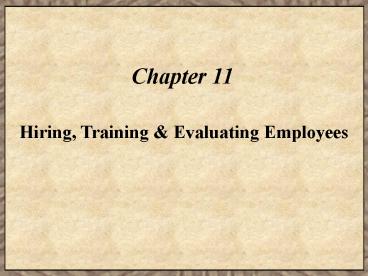Hiring, Training, and Evaluating Employees - PowerPoint PPT Presentation
1 / 17
Title:
Hiring, Training, and Evaluating Employees
Description:
Business Online: Test Samples. Six Important Laws. Providing Equal Opportunity ... Civil Rights Act of 1964. Age Discrimination in Employment Act of 1967. ... – PowerPoint PPT presentation
Number of Views:56
Avg rating:3.0/5.0
Title: Hiring, Training, and Evaluating Employees
1
Chapter 11
Hiring, Training Evaluating Employees
2
Learning Objectives
- Explain human resource planning by firms.
- Differentiate among the types of compensation
that firms offer to employees. - Describe the skills of employees that firms
develop. - Explain how performance of employees can be
evaluated.
3
The Key to a Firms PerformanceHuman Resources
Selecting the best people for the job.
Hiring
Developing the necessary skills of employees to
do the job.
Training
Form a team of employees with the right
background, training and guidance.
Firm's Value
Establishing a formal process to recognize (and
ultimately reward) those employees who performed
well, while offering suggested improvements for
other employees.
Evaluation
4
Human Resource Planning
- The act of planning to satisfy a firms needs for
employment. - Three tasks
- Forecasting staffing needs.
- Job analysis.
- Recruiting.
5
Human Resource Planning
Forecasting Staffing Needs
Job Analysis
Recruitment
Selection
6
Forecasting Staffing Needs
- Determine the right number of qualified people
and where they are needed.
- Three events which require forecasting
- Firm expansion.
- Retirement.
- Temporary increase in production.
7
Job Analysis
- The analysis used to determine the tasks and the
necessary credentials for a particular position.
- The results of Job Analysis are
- Job specification
- Identifies the necessary skills, traits or
attributes for successful performance in a
particular job. - Job description
- States tasks and responsibilities of the job
position.
8
Recruitment
- Involves seeking and attracting individuals from
which a qualified candidate(s) can be selected.
- Internal vs external recruiting
- Internal
- Recruit people within the firm.
- External
- Recruit people outside the firm.
9
Recruitment Screening Process
- Screening applicants
- Assess each application to screen out unqualified
applicants. - Interview applicants to assess personality
characteristics, punctuality, communication
skills, and attitude. - Contact applicants references.
- Use employment tests to assess candidates
abilities. - Make the hiring decision.
10
Steps for Screening Job Applicants
Exhibit 11.3
11
Employment Testing
- One of the most controversial areas in Human
Resource Management.
General Categories Aptitude Psychomotor Job
Knowledge Proficiency Interest Psychological Polyg
raph Drug
Business Online Test Samples
Whats next?
12
Six Important LawsProviding Equal Opportunity
- Equal Pay Act of 1963.
- Civil Rights Act of 1964.
- Age Discrimination in Employment Act of 1967.
- Employee Polygraph Protection Act of 1988.
- Americans with Disabilities Act of 1990.
- Civil Rights Act of 1991.
13
Seven Methods of Compensation
- Salaries and wages
- Stock options
- Commissions
- Bonuses
- Profit sharing
- Employee benefits
- Perquisites
Which one is right for your firm?
14
Skills Development
- Technical
- Decision Making
- Customer Service
- Safety
- Human Relations
15
Employee Evaluations Should
- Be segmented by the relevant criteria for each
job position.
- Provide feedback.
- Provide direction.
- Indicate strengths and weaknesses.
- Determine a raise or promotion.
- Consider objective versus subjective criteria.
16
Direct Measures of Performance
Exhibit 11.8
17
Development of Evaluation Fairness
- Why demonstrate overall fairness to employees
and satisfies legal guidelines.
- Communicate job
- responsibilities.
- Inform employee
- of deficiencies.
Employee evaluation
- Use consistency
- among employees.































